[Note: In a previous version of this post I wrote that the amber specimens were donated to the American Museum of Natural History. That was a mistake. These lizards, like many other important amber-bound fossils, are still held in a private collection and could be sold off tomorrow if the owner so chose.
The wording concerning where the fossils are reposited – or in this case, not – confused me, and I feel especially frustrated by this because I didn’t want to highlight fossils kept out of the public trust. Paleontology, like all science, relies on reproducibility, and that can only happen if significant fossils are held at accredited institutions in perpetuity. That’s the standard, and it’s past time for scientific journals to step up their requirements to match the ethics of the field.]
If you want to follow Earth’s constant and exuberant evolutionary dance, you’ve got to get in touch with the fossil beat. The stacked remains of creatures long extinct provide the essential backstory for every species alive today, marking who emerged onto the stage when and how drastically, or not, their routine has changed through the ages. A single discovery can quickly change the program, however, as a tiny lizard just did for chameleons.
The small squamate, encased in amber, was not a new find from a scientific expedition. The lizard was one of many sold in the private fossil trade out of the amber-rich deposits of Myanmar, winding up in the private collection of James Zigras now made available through cooperation with the American Museum of Natural History. It was one of eight cut-and-polished pieces containing lizards so spectacular that their little scales can be seen, now shown off in high-resolution CT scan detail in a paper by herpetologist Juan Daza and colleagues. Out of this handful of fossils, though, it’s the chameleon that has made headlines.
At less than an inch long, the 99 million-year-old lizard looks like a little scribble in the rock. But thanks to high-tech imaging, Daza and coauthors were able to identify the reptile as a very close relative of chameleons. It didn’t belong to the strictly-defined group that contains modern chameleons, in other words, but is the closest known relative to the group or what paleontologists call a stem chameleon. This must have come as something of a shock. Up until now, the oldest fossil chameleon came from Miocene deposits much closer to us in time. This new lizard stretches the lineage of these charismatic lizards back about 78 million years earlier, meaning that there are a hell of a lot of fossil chameleons waiting to be found in the new gap.

Fossil Facts
Name: There isn’t an official name yet, but the specimen is known as JCZ Bu 154.
Age: About 99 million years old.
Where in the world?: Myanmar.
What sort of critter?: The closest known relative of all chameleons.
Size: Less than an inch long.
How much of the creature’s body is known?: A single, nearly-complete body encased in amber.
Reference:
Daza, J., Stanley, E., Wagner, P., Bauer, A., Grimaldi, D. 2016. Mid-Cretaceous amber fossils illuminate the past diversity of tropical lizards. Science Advances. doi: e1501080
Previous Paleo Profiles:
The Unfortunate Dragon
The Cross Lizard
The Cross Lizard
The South China Lizard
Zhenyuan Sun’s dragon
Zhenyuan Sun’s dragon
The Fascinating Scrap
The Fascinating Scrap
The Sloth Claw
The Hefty Kangaroo
Mathison’s Fox
Scar Face
The Rain-Maker Lizard
“Lightning Claw”
The Ancient Agama
The Hell-Hound
The Hell-Hound
The Cutting Shears of Kimbeto Wash
The False Moose
“Miss Piggy” the Prehistoric Turtle
Mexico’s “Bird Mimic”
The Greatest Auk
Catalonia’s Little Ape
Pakistan’s Butterfly-Faced Beast
The Head of the Devil
Spain’s Megatoothed Croc
The Smoke Hill Bird
The Vereda Hilarco Beast
The North’s Sailback
Amidala’s Strange Horn
The Northern Mantis Shrimp
Spain’s High-Spined Herbviore
Wucaiwan’s Ornamented Horned Face
Alcide d’Orbigny’s Dawn Beast
The Shield Fortress
The Dragon Thief
The Purgatoire River’s Whale Fish
Russia’s Curved Blade
The Dawn Mole

